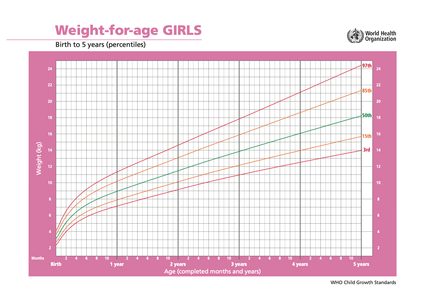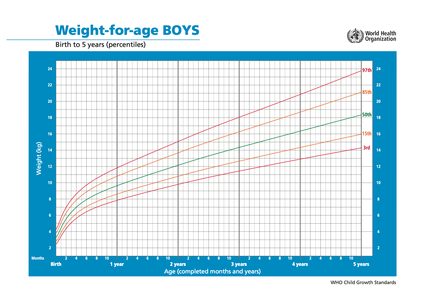Weight Percentile Calculator
Are you curious about your baby's development? Then this weight percentile calculator is for you! You'll learn between which percentiles your child places, and how that relates to their peers. That's not all. In the article below, we explain why we use percentiles and how to interpret the WHO growth chart, and we'll show you a quick example of how this infant growth chart calculator is used.
If you want to assess the height of your kid, use our height percentile calculator.
So, if you've ever asked yourself "what percentile is my baby?", stay with us and read on.
We try our best to make our Omni Calculators as precise and reliable as possible. However, this tool can never replace a professional doctor's assessment. All information on this website is for informational purposes only and is not intended to serve as a substitute for medical consultation. Always consult your results with a healthcare provider.
The aim of the baby weight chart
When assessing a baby's weight, a percentile scale is used. As most children have a specific time when they grow rapidly, require more calories, and reach many developmental milestones, it's not easy to know what your child should weigh at any particular age.
Therefore, the WHO has developed a baby weight chart, which describes the typical trajectory of a kid's development. With this infant growth chart, you don't look solely at how much they weigh, their height, or their BMI, but where among their peers the child is. Also, the baby may gain weight before it begins to grow much taller, or vice versa. You may check their BMI with our BMI calculator for kids.
The most important aspect of weight percentile charts is that they enable the doctor to monitor the child's growth. However, they provide only partial information, and the patient must be assessed as a whole.
It is acceptable when a child grows along the same percentile canal, and the results from other measurement charts are consistent. Similar in the sense that there are no noticeable variations in the charts for height, weight, BMI, and head circumference. A child may be small and stay below the 15th percentile all the time and be perfectly healthy at the same time. However, a difference of more than two canals should cause concern and require an urgent pediatrician consultation.
How to interpret the baby percentile chart
As mentioned above, raw kilograms are not used when assessing a child's development. Doctors consider the rate of growth as an important factor when looking at an infant growth chart:
- On average, the child should follow a similar percentile line on the chart as they grow.
- If the results cross two or more percentile lines (they raise/decrease by at least two ranges), e.g., from the 75th-85th percentile to the 15th-25th percentile, you should consult a doctor.


We derived the data from the WHO (World Health Organization), and the standards were developed using data collected in the WHO Multicentre Growth Reference Study. It is based on the simplified field tables for girls and boys. The calculations are estimated for the age in months but not down to weeks. This tool can be only used if a child is less than five years old. After that age, BMI percentile calculator becomes more indicative of a child's development.
Baby weight percentile calculator — how to use it
Let's explain how to use this kids' growth chart calculator:
-
First, give us some details:
- Age of your child — (either in months or years). The tool is based on a monthly baby weight chart. Note that the tool provides information only for children up to 5 years old.
- Whether they're a boy or a girl.
-
Fill in the weight of your child. You can easily use the in-built weight converter to switch between units.
-
Get the results.
Weight percentile calculator in practice
It's time to show you how this baby weight percentile calculator works — with an example. Let's take Yvonne, a 31-year-old mum of two. The younger one, Vincent, is now five months old. At birth, he received 9 out of 10 on the APGAR score, and his development has always seemed normal, with both weight and height falling perfectly between the 50th and 75th percentiles.
Two weeks ago, Vincent had a little cold, and Yvonne took him to the pediatrician, who checked his percentiles (with the use of our tool and the WHO growth chart).
The doctor entered the values: age: 5 months, sex: male, weight: 8 kg. The result was between the 50th and 85th percentiles.
We try our best to make our Omni Calculators as precise and reliable as possible. However, this tool can never replace a professional doctor's assessment. If any health condition bothers you, consult a physician.
FAQs
What is the child weight percentile?
The child weight percentile is defined as the comparison of weights between the child and the rest of the children among the group of 100. Such that, if the weight percentile is 80, the child is likely to have more weight than 80 children in the group, and less weight than the other 20. The idea is to compare the weight and/or size of the baby compared to their peers.
What do I need to find the child weight percentile?
To find the child weight percentile, you would need:
- The age of your child,
- The weight of your child, and
- WHO child growth chart.
How do I estimate the child weight percentile?
To estimate the child weight percentile:
- Mark the age of your child on the WHO growth chart and trace a horizontal line
- Similarly, mark the weight of your child on the X-axis of the growth chart and draw a vertical line, until it meets the horizontal line.
- The percentile curve on which the intersection occurs is the weight percentile of the child.